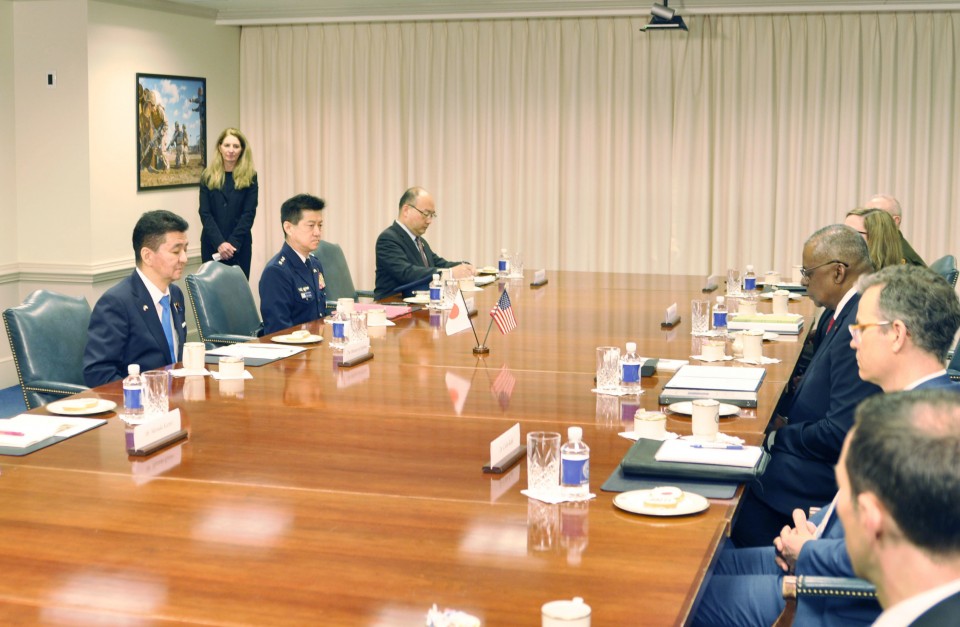[ad_1]
The defense chiefs of Japan and the United States on Wednesday agreed to align the two countries’ security strategies and strengthen cooperation to deter any attempt to change the status quo by force in the Indo-Pacific amid China’s growing assertiveness.
The meeting in the Pentagon took place as Japan plans to update its National Security Strategy by the end of this year, with Russia’s war in Ukraine generating renewed initiative in Tokyo to beef up its own defense and deter potential military aggression in its backyard.

Japanese Defense Minister Nobuo Kishi (L) and U.S. Defense Secretary Lloyd Austin (3rd from R) hold talks at the Pentagon near Washington on May 4, 2022. (Kyodo)
At the outset of the talks, Japanese Defense Minister Nobuo Kishi said Russia’s attack on its neighbor is “a serious challenge to the international order” and that “such unilateral change to the status quo by force is a concern in the Indo-Pacific region as well.”
U.S. Defense Secretary Lloyd Austin said Russia’s aggression has implications “far beyond Europe” because it underscores a challenge to the rules-based order that the United States and its allies have worked hard to build, and warned of Beijing’s behavior that undermines common norms and values.
According to the Japanese government, Kishi conveyed Japan’s “strong resolve” to fundamentally boost its defense capabilities, and Austin welcomed the move.
Japan’s ruling Liberal Democratic Party has recently proposed a substantial increase in defense spending and the development of an ability to attack missile-launching and other key sites in an enemy’s territory.
Such proposals, if included in the Japanese government policy, would mark a major shift in the country’s exclusively defense-oriented policy under the post-World War II pacifist Constitution and also affect the shape of the decades-old Japan-U.S. security alliance.
During the talks, Austin committed to the extended nuclear deterrence provided to Japan. Kishi, for his part, highlighted the growing importance of the two countries working together to make the deterrence reliable and resilient, according to the Japanese government.
The two also reaffirmed the importance of peace and stability in connection with Taiwan, which Beijing views as a renegade province to be reunified with the mainland, by force if necessary.
Russia’s invasion of Ukraine has raised questions as to whether to draw a parallel between the situations in Kyiv and Taiwan, a potential military flashpoint that could draw the United States into conflict with China.
A Taiwan contingency could also pose serious security challenges for Japan, a key U.S. ally geographically in close proximity with the self-ruled democratic island.
China has also been militarizing outposts in disputed areas of the South China Sea and carrying out repeated incursions into territorial waters around the Senkaku Islands, a group of East China Sea islets controlled by Tokyo but claimed by Beijing.
North Korea, meanwhile, has been stepping up its provocative actions, having test-fired an intercontinental ballistic missile in March. It also launched another missile on Wednesday, which could be an intermediate-range ballistic missile or a longer-range one.
Kishi’s visit to the United States is his first since assuming the defense portfolio in September 2020. The last time he met Austin in person was in March 2021, when the U.S. defense and foreign secretaries traveled to Japan for bilateral security talks.
In a virtual meeting of the Japanese and U.S. foreign and defense chiefs in January this year, they shared their concerns about China’s moves to undermine the rules-based international order and vowed to “deter and if necessary, respond” to what they view as destabilizing activities in the region.
[ad_2]
Source link
















